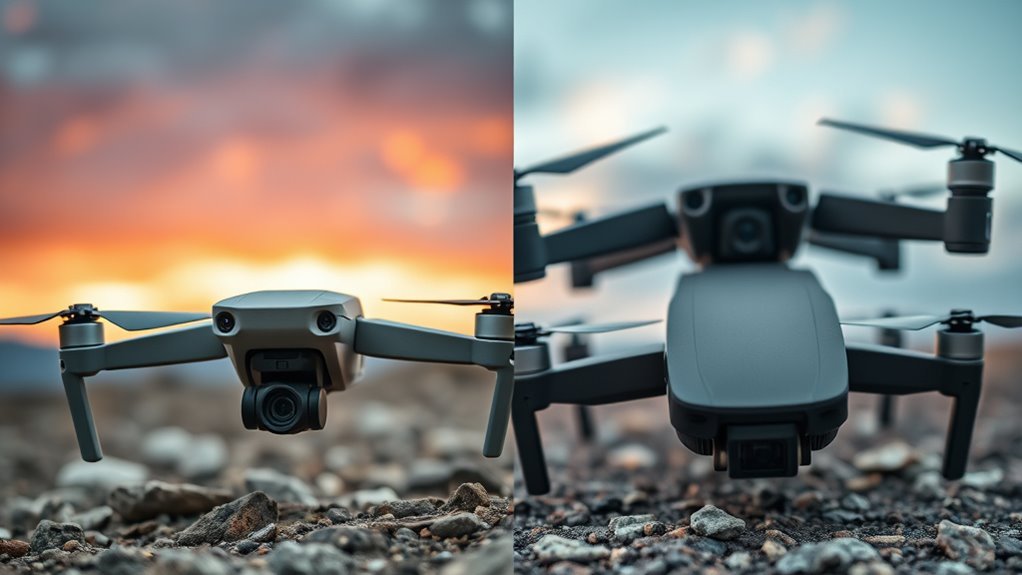You’ll find that the DJI Mini 3 Pro’s 10km O3 transmission outpaces the Anzu Raptor V’s 7km range, offering better reach for exploration. However, Anzu’s NDAA compliance makes it ideal for regulated environments, unlike DJI’s non-compliant design. DJI delivers superior camera quality and flight stability, while Anzu provides cost-effective durability. Further analysis will clarify which suits your needs.
Transmission Range: DJI’s O3 10km vs. Anzu’s 7km
When comparing the DJI Mini 3 Pro and Anzu Raptor V, transmission range plays a pivotal role in performance. You’ll notice the DJI Mini 3 Pro’s O3 transmission technology offers a 10km range, giving you greater freedom to explore vast areas without frequent interruptions. This edge stems from its advanced O3 system, which enhances signal reliability through robust anti-interference measures, ensuring stable connections even in challenging environments.
In contrast, the Anzu Raptor V provides a 7km range, relying on its own transmission technology that prioritizes efficiency but may limit your adventures in open spaces. When analyzing signal reliability, DJI’s system often outperforms by maintaining clearer links over longer distances, allowing you to capture footage with less worry about dropouts. The integration of anti-jamming technology in DJI’s system further contributes to its ability to maintain consistent performance in hostile environments. Ultimately, your choice depends on whether you value extended reach for unfettered exploration or a more compact setup that still delivers dependable performance. This comparison empowers you to select based on your need for liberated flying experiences.
NDAA Compliance and Design Features
While DJI’s Mini 3 Pro raises concerns over NDAA compliance due to its Chinese origins, which restrict its use in U.S. government applications, the Anzu Raptor V stands out as a compliant option, potentially easing your deployment in regulated environments. This NDAA Compliance lets you operate freely in sectors valuing security and autonomy, while Anzu’s Design Innovation focuses on modular, user-centric builds that enhance adaptability without external dependencies. Additionally, Anzu’s commitment to data privacy standards strengthens its position in markets with heightened security needs.
To break it down analytically, consider this comparison:
| Aspect | DJI Mini 3 Pro | Anzu Raptor V |
|---|---|---|
| NDAA Compliance | Non-compliant | Fully compliant |
| Design Innovation | Integrated features | Modular, scalable |
| User Freedom | Restricted access | Open, versatile use |
Performance and Value Comparison
Beyond compliance and design, the DJI Mini 3 Pro excels in performance with its advanced camera capabilities and longer flight times, while the Anzu Raptor V offers greater value through robust build quality and lower costs, enabling you to evaluate which best fits your needs. You’ll appreciate how these drones empower your creative freedom, with the Mini 3 Pro’s superior camera quality delivering sharper images for professional shots, contrasted by the Raptor V’s reliable flight stability in windy conditions.
When choosing, consider these key factors:
- Camera Quality: The DJI Mini 3 Pro’s 4K HDR video outperforms the Anzu Raptor V’s solid 1080p, giving you crisper footage for unrestricted storytelling.
- Flight Stability: Both drones handle well, but the Mini 3 Pro’s advanced sensors provide smoother operation in gusts, enhancing your exploration liberty.
- Battery Life and Range: Mini 3 Pro offers up to 34 minutes flight time versus Raptor V’s 25 minutes, letting you cover more ground without interruptions.
- Overall Value: At a lower price, the Anzu Raptor V provides cost-effective durability, freeing your budget for accessories while matching essential performance needs. Additionally, the advanced cell technology used in DJI’s design optimizes power usage, further extending flight durations.
Frequently Asked Questions
How Long Does the Battery Last?
You’re wondering how long your drone’s battery lasts, as if it were a trusty steed from ancient tales ready for epic quests. When evaluating battery performance, the DJI Mini 3 Pro delivers up to 34 minutes of flight time, while the Anzu Raptor V offers around 30 minutes. Analytically, factors like wind and payload impact this, ensuring you’re free to explore without unexpected grounding. Plan your flights wisely for maximum liberty.
What Camera Resolutions Are Available?
When you’re exploring camera resolutions, you’ll encounter various camera capabilities that offer resolution options like 4K at 30fps or 1080p at 60fps, depending on the model. These settings let you capture stunning details for your adventures, providing the flexibility to balance quality and file size. Analytically, higher resolutions enhance image clarity but may demand more storage, empowering your freedom to create without limits.
Is It Suitable for Beginners?
You’re wondering if this drone’s suitable for beginners. With its user-friendly interface, you’ll navigate controls effortlessly, making learning a breeze. Various flight modes offer simple options to build your skills, letting you explore freely without overwhelming complexity. It’s designed for quick mastery, reducing errors and empowering you to capture the skies independently, all while prioritizing safety and ease.
What Accessories Are Included?
To hit the nail on the head, you’re wondering about accessories that come with your drone setup. Accessory compatibility guarantees these items work seamlessly, letting you mix and match freely. Essential add-ons often include extra batteries, propellers, and a carrying case, boosting flight time and protection. This setup empowers your aerial adventures, offering objective flexibility without extra costs, so you’re always ready to explore unhindered. Stay analytical about upgrades for peak performance.
How Does It Handle in Wind?
When you’re flying your drone in windy conditions, you’ll find its wind resistance helps it cut through gusts effectively, maintaining steady performance. Flight stability guarantees smooth handling, even at higher speeds, allowing you to capture footage without disruptions. This reliability lets you explore freely, giving you the freedom to fly confidently in various environments, enhancing your aerial adventures. Always check local regulations for safe operation.

